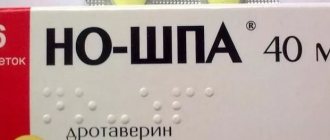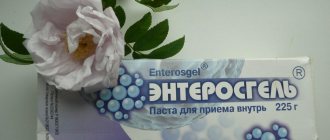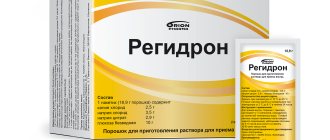Smecta is one of the safe drugs that you can rely on to solve digestive problems in very young children. This French medicine is available in powder form or a ready-to-use suspension. The drug is sold in sachets intended for single use.
Composition of Smecta
The active ingredient in Smecta is dioctahedral smectite (diosmectite), obtained from white clay of volcanic origin from the island of Sardinia. Each diosmectite plate is designed in such a way that it allows it to attract and hold polar molecules, that is, it exhibits adsorption properties. The drug is capable of not only removing harmful substances and microorganisms, but also enveloping the intestinal walls, creating a protective barrier, restoring the mucous membrane.
Composition of Smecta in powder form:
- dioctahedral smectite – 3 g;
- glucose;
- sodium saccharin;
- vanillin.
Composition of Smecta in suspension form:
- dioctahedral smectite – 3 g;
- caramel-cocoa flavoring;
- xanthan gum;
- lemon acid;
- ascorbic acid;
- potassium sorbate;
- sucralose;
- water.
Is it possible for a newborn to have Smecta?
This drug is safe for the child, as it does not linger in the baby’s body and is excreted naturally in its original form. However, in some cases, allergic reactions to the components of the drug, as well as constipation, may occur. The latter disappear when the dosage of Smecta is reduced.
Important! Taking the drug may cause or worsen existing constipation.
Application of Smecta in infants:
- elimination of symptoms of acute and chronic diarrhea (diarrhea) caused by allergies, poisoning, infections (as part of complex therapy);
- flatulence (bloating) with colic.
Contraindications
The drug has a minimum of contraindications. This is an allergy to any component of the drug and intestinal obstruction. The use of Smecta in newborns is prohibited.
Treatment of defecation disorder sometimes involves a long process of diagnosis and therapy with antibacterial drugs and sorbents. Using antidiarrheals without a doctor's prescription can result in delayed treatment, dehydration, and other complications. Determine the cause of the child's diarrhea and follow the doctor's instructions.
The article was approved by the editors
Smecta dosage for other indications
| Age | Dosage |
| Up to a year | 1 sachet per day |
| 1-2 years | 1-2 sachets per day |
| 2 years | 2-3 sachets per day |
Important! Before opening the sachet with the liquid form of the drug, it must be thoroughly kneaded with your fingers so that the contents become homogeneous.
The drug is usually taken between meals. For bottle-fed babies, it is recommended to dissolve the contents of the sachet in 50 ml of boiled water or pre-diluted infant formula and give it in a bottle. For children already receiving complementary foods, you can mix Smecta with broth, puree or other liquid or semi-liquid food.
Important! It is not recommended to store the prepared suspension of the drug for a long time. The maximum shelf life in the refrigerator at a temperature of 6-8°C, unopened, is 16 hours.
Since the drug has an adsorbing effect, it is able to bind not only harmful, but also beneficial substances, therefore Smecta is not recommended to be taken simultaneously with other medications, including antibiotics. If such a need still exists, the drug can be given only 1-2 hours after taking it. For the same reason, Smecta should not be given during or immediately after meals. Nutrients from food can be bound by diosmectite and the child simply will not receive them.
The maximum duration of taking the drug should not be 7 days. If after this period the symptoms do not decrease or are accompanied by vomiting or fever, you should seek help from a doctor.
Instructions for use for children of different ages
To prepare a medicinal suspension, the contents of 1 packet should be diluted in water. For adult patients, you will need half a glass of liquid, for children - 50 g. It is forbidden to dilute the powder with juices, compotes, or mineral water.
The drug can affect the absorption of other drugs. When taking Smecta and other tablets or powders, the time interval should be observed: half an hour before or after two hours.
Instructions for use for children of different ages in the complex treatment of acute gastrointestinal disorders:
- Newborns – from birth to 28 days – does not apply.
- Infants from 1 month to 1 year – 2 sachets per day for 3 days. Then one per day. The drug is diluted in water and added to milk, adapted mixture, fruit and vegetable purees.
- One-year-old children and up to 4 years of age - 4 sachets per day for the first 3 days of therapy. Next, 2 packages each.
- From 4 years and older, including adult patients – 3 sachets per day. In the first 3 days, the recommended dosages should be doubled to 5-6 packets of the drug.
Instructions for using smecta for diarrhea in children that occurs in a chronic form and causes discomfort in the gastrointestinal tract:
- Ages from 1 month to a year – contents of 1 sachet.
- From 1 to 2 years – 1–2 packets per day.
- From 2 to 14 years – 2–3 sachets per day.
- From 14 years old and adult patients – 3 packets per day.
These are the dosages of the drug recommended by the manufacturer. The doctor decides how to give it correctly and for how many days based on the child’s condition and his reaction to the treatment.
When treating with Smecta, measures should be taken to prevent dehydration and offer the baby food. If you have no appetite, don’t insist! Switch to a dietary form of nutrition for older children!
Side effects of Smecta
There are few side effects from Smecta, so it is approved for use from a very young age.
- Quite often causes constipation.
- Flatulence and vomiting are much less common.
- With caution in diabetes mellitus due to the presence of glucose.
- Cases of allergies have been reported extremely rarely.
Sometimes taking this drug is associated with a change in the color of the child's stool, which is not correct. Smecta does not have this ability, since it does not interact in any way with food components and is excreted from the body in its original form. For the same reason, the appearance of green diarrhea or mucus cannot be attributed to taking the drug.
Features of Smecta
Since smecta is completely excreted from the body unchanged, it is very actively and widely used to treat young children.
It is not absorbed into tissues and does not affect the functioning and functions of internal organs.
Smecta can be given in two cases:
- For the treatment of diarrhea in infants
- Treatment and elimination of symptoms in disorders of the gastrointestinal tract
If a newborn is prescribed smecta along with other medications or vitamins, then it can be given only 1 hour after taking them or 2 hours before.
This is an important condition, because smecta slows down and reduces the work of other drugs. It is not addictive and has almost no side effects.
In rare cases, it can cause allergies or raise the baby's body temperature. In this case, such treatment is completely excluded.
Sometimes smecta can cure diarrhea, but at the same time, constipation occurs in infants. This indicates that the wrong dosage of the drug was chosen. When the amount of the drug is reduced, such symptoms disappear.
Smecta for infants with diarrhea
The use of this remedy for diarrhea is the most common. It is important to note that in parallel, children must undergo procedures to prevent dehydration - rehydration therapy. If the intensity of diarrhea is low, then the mother can monitor the child’s condition, replenishing fluid loss by the body in the simplest form using boiled water, and best of all, using Regidron, which will replenish not only the amount of water, but also the balance of salts. In severe cases, it is necessary to go to a hospital, where the amount and method of fluid administration will be selected depending on the age and condition of the child.
Sometimes pediatricians recommend using Enterol in the complex treatment of diarrhea. It contains lyophilized Saccharomyces boulardii, which can suppress pathogenic microflora without causing a harmful effect. The drug also has an antitoxic effect.
Indications for use of Smecta for diarrhea
Smecta for diarrhea in adults and children is used regardless of the cause of the peristalsis disorder. Doctors include enterosorbent in therapeutic regimens when they detect the following conditions in patients, accompanied by diarrhea:
- toxic damage to the mucous and muscular layer of the stomach;
- intestinal disorders caused by irrational, unbalanced and (or) monotonous diet;
- irritable bowel syndrome (in complex treatment);
- chronic pathologies of the gastrointestinal tract, including gastritis, colitis, enterocolitis;
- peristalsis disorders as a result of a course of antibiotics, cytostatics, glucocorticosteroids;
- intestinal, respiratory, urogenital infections, manifested by diarrhea.
It is recommended to use Smecta in powder for children and adults not only to eliminate the frequent urge to have a bowel movement. After all, the above diseases manifest themselves simultaneously with other symptoms. Enterosorbent quickly eliminates diarrhea, flatulence and heartburn, sour belching and stomach pain, bloating, and rumbling in the intestines.
Smecta for jaundice in newborns
Smecta's ability to bind and remove harmful substances from the body allows it to be used for physiological jaundice of newborns. This is a condition in which embryonic hemoglobin is gradually destroyed, and in its place is formed that is characteristic of an adult. As old red blood cells break down, they release bilirubin, which should normally be excreted by the liver, and since the newborn’s liver is not yet functioning at full capacity, bilirubin that is not excreted from the body can give the skin a yellow tint. Typically, physiological jaundice disappears by 7-8 days from birth, but Smecta can be prescribed to speed up the process and reduce the load on the liver.
Smecta for colic and dysbacteriosis
The most common cause of colic is increased gas production (flatulence).
This condition manifests itself in painful, cramping pain in the baby’s tummy, inconsolable and prolonged crying. Flatulence can occur in the absence of pathology (primary and secondary lactase deficiency, malnutrition of a nursing mother, swallowing air while eating), as well as in its presence (acute intestinal infections, intestinal obstruction, inflammatory bowel diseases). Therefore, before starting treatment, it is necessary to exclude pathological causes that require immediate consultation with a doctor.
Dysbacteriosis can also cause increased gas formation, but in a newborn this is rather a temporary phenomenon associated with the process of colonization of the gastrointestinal tract with microflora. Here, after consultation with a pediatrician, it would be more appropriate to prescribe probiotics containing beneficial microorganisms (Linex, Hilak Forte).
Gas in a baby can be recognized by its tight, inflated tummy. Smecta will help alleviate the child’s condition, which will remove everything unnecessary from the intestines, including gases, toxins, viruses and bacteria.
An effective remedy for diarrhea
Smecta is an ideal medicine that can be given for diarrhea. It effectively copes with its task without leaving any side effects.
The main thing is not to overdo it with the dosage so that diarrhea does not give way to constipation.
Diarrhea is a consequence of dysbacteriosis. Smecta effectively restores the imbalance of bacteria in the intestines and is completely eliminated from the body.
All harmful bacteria and toxins come out with it. The beneficial bacteria included in the drug populate the intestines, bringing the organs of the gastrointestinal tract to a healthy state.
It is very important to monitor the health of infants, because the first year of their life is considered the most critical. At this time, all vital organs and their functions are formed.
And wonderful medications can help with this, which must be taken only after consultation with a doctor.
Smecta for vomiting and poisoning
The most common causes of vomiting are infectious diseases of the gastrointestinal tract and poisoning. Since Smecta has adsorption properties, taking it helps remove harmful substances and microbes from the intestines and stomach. The dosage is the same as for diarrhea, but if another attack of vomiting occurs after taking the medicine, a second dose is required. But vomiting is not always caused by infection or poisoning. Vomiting can accompany fever, head injury, nervous disorders, and taking Smecta will be useless here. Thus, before taking the drug, it is necessary to know the cause of vomiting.
Instructions for use of Smecta for diarrhea
Following the recommendations of the instructions for use of Smecta will allow you to avoid side effects. But sometimes the doctor calculates the dosage individually. Only for esophagitis you need to take enterosorbent orally after meals. In other cases, it is better to use it before breakfast, lunch and dinner. The presence of food in the stomach will somewhat delay the therapeutic effect.
The duration of action of Smecta for diarrhea varies from 7 to 8 hours, with the first fixing effects appearing after 15-30 minutes.
Eating after taking Smecta is allowed no earlier than half an hour later. This time interval is quite sufficient for the movement of aluminosilicate towards the intestine.
If after 2 days of using the drug the severity of diarrhea does not decrease, you should consult a doctor. It will complement the treatment regimen, adjust the dosage regimen, or replace Smecta with a more effective drug.
Smecta for allergies
The sorbing properties of Smecta allow it to be used not only to remove toxins, viruses and microbes, but also allergens. The binding of allergens and poisons begins in the acidic environment of the stomach, then in the small intestine substances taken orally, as well as secretions of the mucous membrane, liver and pancreas, are bound, and in the large intestine microorganisms and their toxins are bound. Thanks to this action, toxic-allergic reactions are reduced.
Important! Smecta is recommended for use for allergies with severe diarrhea. In the absence of diarrhea, it is better to opt for Polysorb or Enterosgel so as not to provoke constipation.
Smecta for rotavirus
This drug can be used for infections, including rotavirus. Due to the presence of medium and large pores in dioctahedral smectite, it is able to easily capture bacteria and viruses, as well as their metabolic products. Taking Smecta significantly alleviates the patient’s condition, but is not able to completely cure it. Therefore, the drug is recommended for use as part of complex therapy with intestinal antiseptics. The drug Enterofuril, which has a wide spectrum of action, is not absorbed into the blood and does not disrupt beneficial microflora, has proven itself well for this purpose.
Composition and effect of the drug
Smecta belongs to the pharmaceutical group “antidiarrheals” used for bacterial and infectious intestinal disorders and enterosorbents. Produced in France.
Indications for prescribing the drug:
- symptomatic therapy for diarrhea in patients of different ages;
- prolonged diarrhea;
- treatment of pain associated with gastrointestinal diseases.
The main active component of the drug is dioctahedral smectite or double silicate of aluminum and magnesium. This is a substance of natural origin. Other components are considered auxiliary.
In appearance it is a white powder with a vanilla or orange aroma. The color of the drug may change to light beige, which is not a sign of spoilage. The medicine is packaged in individual packages.
The drug has the following effects:
- adsorption of toxic substances, bacteria, viruses;
- enveloping - due to the high viscosity of the main component;
- barrier – the resulting mucus protects the mucous membrane of the stomach and intestines from the effects of toxic substances, preventing their absorption;
- improves the functions of the gastrointestinal mucosa.
Dioctahedral smectite is not absorbed into the systemic bloodstream, does not undergo chemical transformations, and is excreted in the feces unchanged.
The drug is an over-the-counter drug from a pharmacy.
Analogues of Smecta for children
There are analogues of Smecta in terms of active substance and mechanism of action.
Analogues of the active substance are:
- Neosmectin;
- Diosmectite.
Important! According to the results of some studies, Neosmectin contains less iron and more magnesium than Smecta and therefore causes constipation much less often, especially with long-term use of the drug. Neosmectin, unlike Smecta, is available only in powder form.
Analogues by mechanism of action:
- Based on activated carbon (Activated carbon, Karbolen, Gastrosorb, Carboctine);
- Based on silicon dioxide (Polysorb);
- Based on lignin (Polyphepan, Filtrum, Laktofiltrum);
- Obtained by chemical synthesis (Enterosorb, Enterodes, Enterosgel).
The mechanism of action means, first of all, the ability to sorption. However, most of these drugs cannot coat the gastrointestinal mucosa, protecting it from damage.
When comparing the ability to sorb, it is necessary to pay attention to the sorption capacity. Large sorption capacity provides greater absorption capacity. Data on the sorption capacity of Smecta in relation to analogues are not the same and it is difficult to say anything about this, since each manufacturer praises its product. However, here we must not forget that by sorbing everything, you can cause harm to the body due to the absorption of useful substances.
Medicines that can be used as analogues of Smecta
There are cases when the use of Smecta is impossible due to the lack of this drug on pharmacy shelves or for other reasons.
In such a situation, you can use similar means that have a similar component composition and an identical principle of action on the body during diarrhea.
Among the analogues of Smecta, the most suitable are:
- DioSmectite. The cost of this drug is almost the same as that of Smecta, however, if the doctor prescribed Smecta for your child, you need to consult with him again to see if it can be replaced with such a drug and how suitable it is for your child.
- NeoSmectin. It has a similar effect to Smecta, but has other contraindications; for example, it is not recommended to use this drug if your child is diagnosed with diabetes. This product is quite cheap, but you should still consult with your child’s doctor before use.
- Polyphepan. It is not recommended for use in the presence of ulcers; it is necessary to diagnose the child before use for individual intolerance to the components of the drug, as it can cause an allergic reaction.
- Enterosgel. It can be used as a remedy similar to Smecta; it must be used with extreme caution, having first studied the instructions for use.
Thus, when treating diarrhea in a child, an important main aspect is choosing the right medicine.
Smecta as a drug to improve the condition is a fairly effective drug, however, if you choose, you can use similar medications with identical effects.
Smecta will help your child reduce the symptoms of diarrhea and generally cope with this disease in the shortest possible time.
Before use, it is recommended to consult a doctor who will help conduct a quality diagnosis and correctly prescribe the necessary therapy.
While taking this medication, an important element is maintaining a certain diet, as this promotes better absorption of Smecta and a speedy recovery.
Diarrhea in children is a dangerous symptom that must be prevented as soon as possible. Smecta for diarrhea in a child is one of the best options for safe and effective normalization of stool, which is confirmed by reviews from pediatricians and parents. It is important to follow the instructions and know some of the features of taking the drug.
The drug contains a sorbent, microparticles of which absorb harmful compounds into their surface that spread in the intestines. After some time, they naturally leave the body, capturing on their surface substances that provoke stool disorder.
Smecta acts selectively, removing harmful substances from the body, including gaseous substances. The composition is active against toxins, some types of fungi, intestinal microorganisms and a number of other elements, the presence of which leads to diarrhea. Simultaneously with absorption, Smecta promotes:
- maintaining the natural protective functions of the intestines by maintaining the structure of the mucus;
- normalization of intestinal motility;
- enveloping the walls of the stomach, reducing the irritant factor;
- does not interact with tissues, which prevents the drug from entering the bloodstream and affecting other organs.
An important feature of the principle of action of Smecta is the careful release of the digestive organs from substances that disrupt normal intestinal functions. This ability makes it possible to use the drug for newborns, as well as for children of different ages.
Smecta contains the main active substance - dioctahedral smectite (diosmectite). The compound is a powerful enterosorbent and is of natural origin. Its properties are comparable to clay with a porous structure; it is not digested or absorbed by the body.
For a pleasant taste, citrus and vanilla flavors are added to Smecta, which makes it easier for children to take the medicine. The composition contains minimal amounts of potassium sorbate, ascorbic acid, and citric acid monohydrate.
Available in powder form, packaged in 3g packs. There is a brief dosage instruction on the back.
The effectiveness of the drug depends on the chosen dosage and rules of use. For each age and clinical picture, the amount of medicine is selected individually. You need to especially carefully monitor the dose and frequency of administration if Smecta is planned for children under one year of age. In other cases, you should not neglect the instructions either. There is a possibility of no results, which will only negatively affect the overall well-being or the onset of defecation delay. The condition is not dangerous, but will cause additional discomfort.
For babies under one year old, Smecta should be given twice a day, ½ sachet. If there are symptoms of severe stool disorder (more than 10 times a day), then it is allowed to give 2 sachets per day, but not exceeding 2-3 days.
Since diarrhea can be a symptom of serious disorders of the digestive system, consultation with a doctor for a newborn is mandatory.
For children from one to three years of age, the daily norm increases to two sachets and 2 times a day for moderate type disorders. In critical situations, you are allowed to take the medicine 3 times.
If the child is over three years old, the permitted dose is 3 sachets per day, provided the diarrhea is not severe. If there is a particularly frequent urge to defecate, you can increase the frequency of administration up to 4 times, one package at a time.
Depending on the provoking factors and the condition of the little patient, the doctor may adjust the dosage. Smecta for vomiting in children is prescribed in similar dosages as for diarrhea. In case of poisoning, these symptoms often appear simultaneously, and with the help of the drug you can have a complex effect.
Its effectiveness depends on compliance with the rules for using the drug. This applies not only to the dosage, but also to the order of administration. It is important for Smecta to adhere to the following recommendations:
- It is necessary to prepare the solution only before use, since when storing already dissolved powder, its adsorbing property decreases.
- For newborns, the powder can be mixed with formula and breast milk.
- The medicine is taken an hour before meals or several hours after meals. The exception is treatment for infants, when it is difficult to endure such periods. In such cases, it is advisable to give the solution 30 minutes before feeding.
- The simultaneous use of Smecta and a drug with another directed effect is agreed with the doctor or used at intervals of several hours. Due to its adsorbing properties and ability, there is a possibility of reducing the effect of other medications.
- Treatment from 3 to 7 days. Long-term use of the drug is discussed with the attending physician, since diarrhea for more than a week is a symptom that requires targeted therapeutic measures.
- The powder should be diluted with water only in the specified proportions.
- The child needs to be provided with a sufficient amount of fluid, not to overfeed, and not to include new foods in the diet.
The pediatrician gives special instructions for treating a child for diarrhea, focusing on the main diagnosis and the cause of the disorder.
Smecta is a universal remedy that helps fight various gastrointestinal and intestinal disorders. The main indications for use include:
- Digestive disorders with different etiologies.
- Poisoning caused by viral or bacterial pathogens.
- Allergic diarrhea.
- Dysfunction of the digestive organs.
- Gastrointestinal diseases, including ulcers, gastritis, colitis and other pathological conditions of acute and chronic type.
- Attacks of colic, increased gas production.
- Dysbacteriosis that arose against the background of intestinal immaturity and microflora disorders.
- Consequences of complementary feeding when introducing a new product.
- Recovery period after infectious diseases.
Smecta is prescribed to prevent intoxication of the digestive system, normalize stool during long-term use of medications and antibiotics. The course of treatment of viral and infectious diseases involves the use of Smecta after the main therapy.
Regardless of whether you plan to give Smecta to a 1-year-old child, a newborn, or whether an older child or adult needs help, it is important to exclude contraindications. There are few of them for this drug, the main ones are considered to be: intolerance to diosmectite, allergy to auxiliary compounds. In rare cases, a reaction to flavoring agents may occur.
In case of intestinal obstruction or frequent constipation, it is better to limit the use of Smecta, as there is a risk of worsening the situation. In exceptional cases, redness, rashes in the form of hives, and mild itching may occur. If such manifestations occur, you should stop taking the drug and consult a doctor.
Compared to other drugs with similar effects, Smecta is considered the safest. This is confirmed by the possibility of using diluted powder for newborns, as well as for pregnant women during lactation.
For children, analogues of the Estimate are selected in relation to the main problem. If you need to cope with colic, bloating, there are drugs Bobotik, Espumezan, dill water. Diarrhea due to gastrointestinal disorders can be eliminated with the help of Diosmectin, Enterosgel, which is suitable for long-term use, but is not a budget option and has a specific taste, which makes it difficult for children to take.
The closest analogue of Smecta is Neosmectin. The medicine has identical indications and is available in three fruit flavors. Available in powder form, the packaging is slightly larger than a bag of Smecta. There are no age-related contraindications.
The classic and well-known adsorbent in the form of activated carbon is best not used for small children. An overdose leads to serious complications for an unformed organism.
If for some reason it is impossible to use Smecta, then choose analogs that are specially adapted for children. For this purpose, contraindications are carefully studied.
I have been using Smecta since my baby started teething, almost 5 months. As soon as a tooth comes out, so does diarrhea. If measures are not taken, diarrhea intensifies with all the unpleasant consequences. We immediately start drinking the powder 2 times a day (the child is one year old) and this is already enough to normalize the condition. Smecta was recommended by the pediatrician while still in the maternity hospital in case of stool disorder.
Christina
I tried Smecta when my child and I went on vacation and on the way we started having diarrhea, the whole family. The adults took pills against diarrhea, but the youngest were not allowed to take them, since the contraindications include age up to three years. I gave the bag three times a day, started in the morning, and by the evening the baby began to ask to go to the toilet less often, and the vomiting stopped. Now Smecta is always in our medicine cabinet, an effective and safe drug, I give it to children and drink it ourselves when we have problems with stool.
Elizabeth
I gave Smecta to two of my children, one is 13 years old, the other is 2 years old. Both suffered from rotavirus infections with all the consequences in the form of diarrhea, severe vomiting and fever. The eldest drank a sachet from me 4 times a day, and the youngest three times a day. Naturally, at the same time I was treating for this virus, but improvements in stool were already noticeable the next day, although we have not yet completely gotten rid of this infection. A budget option compared to medications with similar effects.
Natalia
My child is allergic, and his reaction to foods is not only visually visible, immediately covered with red spots, but also reflected in the stool. Smecta was recommended to us by the doctor who was observing us as a means of restoring normal stools and as a substance that helps remove toxins and aggressive compounds from the body. In our case, this is very important, because the faster the child’s body gets rid of the remnants of the allergen.
Victoria
Summarizing all the information about Smecta, as well as focusing on reviews from parents, we can confidently say that the drug is really useful for the treatment of various disorders of the digestive system in children. The composition allows you not only to effectively fight diarrhea, but also to carefully cleanse the intestines of harmful compounds.











